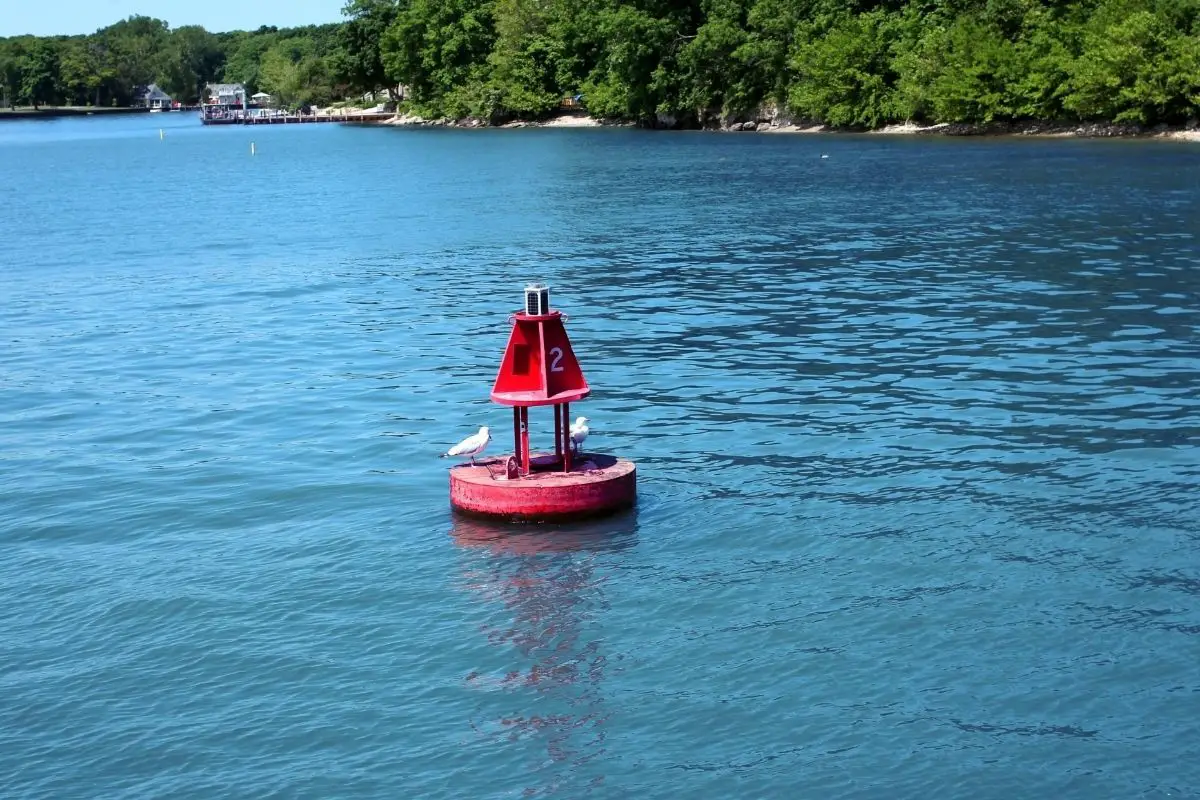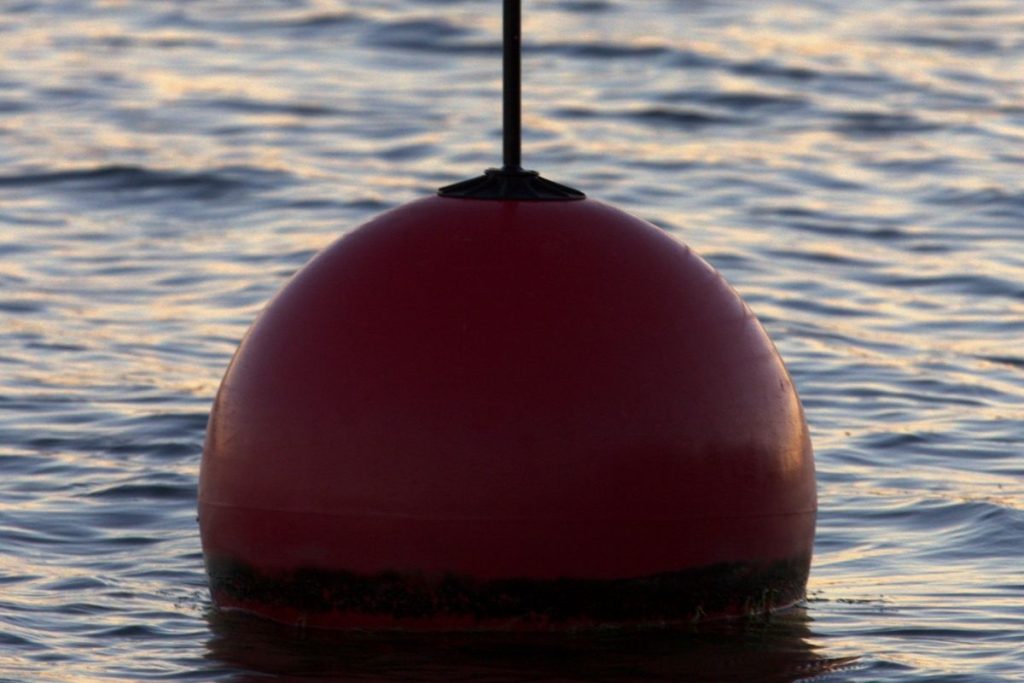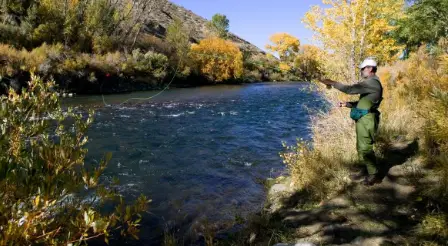Whether you are an avid sailor who travels the world or you noticed them from the view of a cruise ship, red buoys seem to be everywhere when you travel across the water.
And there is a good reason for that. Buoys are important navigation markers that indicate where a ship can safely travel.
But have you ever wondered what a red cone-shaped buoy means?
In this article, we explore the different types of buoys and what a ship should do when it comes across a red buoy.
What Are Buoys mark?
A buoy is a floating object that can be used to mark the edges of the waterway where a ship or other vessels pass through.
Buoys and markers are usually made from wood or metal.
A buoy may also be used as an aid for navigation by marking the position of shoals, reefs, rocks, or other dangerous areas in a body of water.
Types Of Buoys
There is a range of types of buoys that have different shapes, colors, and numbers.
Can Buoy
Can buoys are a cylindrical shape. This buoy always is a green color and indicates an off number.
These green buoys mark the edge of a channel when entering a port from the open sea on the left side.
Nun Buoy
These red buoys are cone-shaped and feature an even number. Nun buoys are the opposite of Can buoys as they indicate the edge of a channel on the starboard side (right) when it enters from the open sea.
Lighted Buoys
Lighted buoys use typical lateral marker shapes, together with matching numbers and colors. They also have a colored light so they can be seen better.
Other Types Of Buoys
The buoys mark mentioned above are all navigation buoys that show a vessel where it can travel safely.
Mooring Buoys
When a ship needs to moor in the open sea or other bodies of water, it traditionally puts out an anchor. Mooring buoys are a modern alternative to anchors.
They are much quicker to place and they are not as invasive as anchors. This allows other operations near the vessel, for example in a port, to continue.
Originally, mooring buoys were made of steel and other hard-wearing metal. However, the steel led to several issues, including rust, which made them unusable over time.
Steel buoys are also very heavy, which makes them difficult to repair in the open sea.
The paint these old metal buoys were painted with would regularly flake off or fade in the sunshine, which would require frequent repairs.
On the other hand, our modern plastic mooring buoys don’t have any of these issues. They don’t rust and need a lot less maintenance.
In addition, plastic buoys are also much cheaper to produce and buy.
Their lighter weight has made them ideal for larger seaports, where they can be moved much easier than steel buoys.
One of the greatest benefits for the environment, however, is that polyethylene mooring buoys can be recycled at a much lower cost than steel, and they last considerably longer.
These lightweight buoys are not only ideal for hazards but can also indicate safe water areas.
For example, divers can moor up near reefs without dropping anchor. This reduces the risk of damaging the reef and local habitat.
What Is A Data Buoy?
Data buoys are used for collecting environmental, oceanographic, and meteorological research data.
This could be information around the weather, like measuring air pressure and water levels.
A Brief History Of Buoys

Tyger Leader is reader-supported and may earn a commission when you book or purchase using our links. Learn more about our affiliate disclaimer here.
The concept of a navigation system for waterways and indicators of hazards in the water goes back a long time in history.
The ancient Egyptians initially developed markers to indicate rocks and other dangers in the water.
What Are Markers?
Just like buoys, markers are waterway traffic signals that indicate the edges of safe areas in the water. Markers and buoys can be found, for example, to direct traffic through a channel.
A marker, also called a lateral marker, is typically used in combination with numbers and colors which always have the identical meaning, irrespective of what type of marker or buy they are.
What Does It Mean When A Cone-Shaped Buoy Is Red?
A cone-shaped, fully red buoy is a so-called Nun buoy. It marks the edges of a channel on the right side of a ship when it enters a port from the open sea.
As a general rule of thumb in sailing, all starboard hand buoys (right) are red and port hand buoys (left) are green.
These buoys indicate the different sides of a channel and which one is safest to navigate.
Green buoys must always be passed on the left side of the vessel when heading against the current.
On the other side, a vessel must keep red buoys on the right side when going upstream.
The direction of the current varies across the world, and it is commonly determined by either the tide or consensus.
For this reason, vessels must familiarize themselves with the individual navigation aids in the region where they travel.
What To Do When You See A Red Buoy?
Red buoys indicate the right side of a ship so when a vessel passes through two buoys, it needs to keep the red buoy on its starboard side.
You may have heard the phrase “Red Right Returning”. This is a useful reminder for everyone steering a boat, ship, or other vessels when heading upstream or returning from the open sea.
“Red Right Turning” means that a vessel should keep red markers on its right side when returning upstream from open water.
Frequently Asked Questions
Get your last-minute questions answered here!
How Do Buoys Stay In Place?
To keep a mooring buoy in place, you need a strong anchor system. It needs to be durable and strong to withstand all weather conditions in the open sea and ports.
Why Do Buoys Move?
Buoys are moved regularly to use them where they are needed. They may be assigned to new vessels or rented to passing vessels.
Conclusion
Buoys are an essential part of maritime traffic management. They help ships safely navigate channels and protect people who work at the shoreline.
They provide valuable information about the environment and the safety of shipping lanes.
Buoys are not only visible but also audible, as they make noise when they move. This makes them very effective warning devices.



